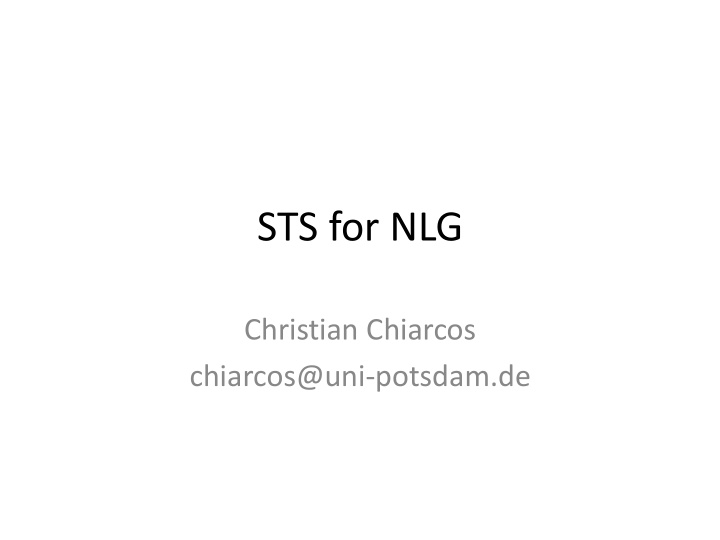



STS for NLG Christian Chiarcos chiarcos@uni-potsdam.de
Natural Language Generation • Natural Language Generation (NLG) (...) is a subfield of artificial intelligence and computational linguistics that is concerned with building computer software systems that can produce meaningful texts in English or other human languages from some underlying non-linguistic representation of information. Reiter & Dale 2000
input data base unstructured data-base entries context model content selection which pieces of information text planner should be uttered ? knowledge text structuring mapping facts on propositions bases how to arrange propositions ? user structured model aggregation propositions how to combine propositions to utterances ? communicative lexicalization sentence planner goals which lexemes, which grammatical mapping propositions to sentence plans structures to choose ? referring expressions sentence which type of referring expression plans to choose ? surface realization realiser assigning correct morphological markers, etc. mapping sentence plans to sentences NLG system sentences pipeline architecture output Lorem ipsum dolor sit amet, consectetur adipisici elit ...
NLG applications • generating text from large bodies of numerical data – weather reports (Belz 2008) • generating text from a large knowledge bases – museum guide (O‘Donnell et al. 2001) • interactive hypertext – book recommendations (Chiarcos & Stede 2004) • taking the information status of the addressee into account • user-tailored – BabyTalk (Gatt et al. 2009) • automatically generated medical reports for nurses/doctors (informative) and parents (affective) • informative, instructional or persuasive texts
NLG evaluation: human • task-oriented evaluation – measure impact on end user, e.g., mistakes (for an instructional text, Young 1999) • human ratings and judgements – expert ratings according to criteria like coherence and (linguistic) quality (Lester and Porter 1997) • expensive and time-consuming
NLG evaluation: automated • evaluation by comparison with human written text – i.e., texts written by experts from the same data • or (in combination with a parser) corpus regeneration (Cahill and van Genabith 2006) – cheap, fast, repeatable (if we have the corpus)
NLG evaluation: automated • n-gram metrics – BLEU (Papineni et al. 2002), from MT – ROUGE (Lin and Hovy 2003), from Summarization • concerns – cannot capture higher-level information (e.g., information structure, Scott and Moore 2007) => evaluate correlation with human judgements (Reiter and Belz 2009)
NLG evaluation: automated vs. human • Belz & Reiter (2009) – weather reports – human: experts and non-experts – automated: BLUE, ROGUE – criteria • „clarity and readability“ (= linguistic quality) • „accuracy and appropriateness“ (= content quality)
NLG evaluation: automated vs. human – Belz & Reiter (2009) • significant correlations only with clarity, but not with accuracy – strong influence on the design of subsequent NLG shared tasks • focus on task-based evaluation – GIVE, GIVE-2 (Giving Instructions in Virtual Environments) – GRUVE (Generating Route descriptions in Virtual Environments) • automated metrics mostly for the evaluation of surface realization – Surface realization challenge (BLUE, ROUGE, METEOR*) * METEOR is a simple semantic metric using lexical similarity (synonyms)
NLG evaluation vs. STS • Automated evaluation would benefit strongly from STS – automated, content-sensitive metrics are still an open research question in NLG • NLG provides particularly strong motivation to include discourse in STS – unlike summarization and MT, we cannot just keep an existing structure
Recommend
More recommend